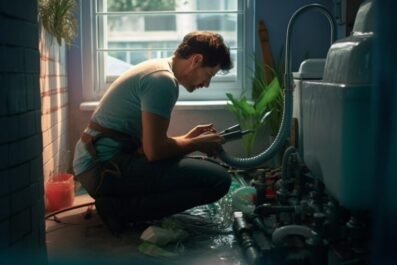Eco-Friendly Home Improvement Ideas for a Greener Household

In today’s world, sustainability is more than just a buzzword; it’s necessary. As concerns about climate change and environmental degradation continue to rise, homeowners increasingly turn to eco-friendly home improvement solutions to reduce their carbon footprint and create a greener household.
The good news is that the green approach offers monetary benefits in return. If you invest thousands in installing solar panels, your property will sell for a higher value and pay you back!
In addition, there are health benefits, such as the satisfaction of being eco-friendly, reducing your carbon footprint, and, of course, making the planet a better place for future generations.
In this article, we’ll explore some of the top eco-friendly home improvement ideas for a greener household,
Bedding: Why Choose Non-Toxic Options
When we think about eco-friendly home improvements, bedding might not be the first thing that comes to mind. However, the materials used in our bedding can significantly impact our health and the environment.
Conventional bedding often contains harmful chemicals such as formaldehyde, flame retardants, and volatile organic compounds (VOCs), which can off-gas and contribute to indoor air pollution.
Opting for non-toxic bedding made from organic materials such as organic cotton, bamboo, or hemp can help reduce exposure to these harmful substances and promote better indoor air quality.
You might take time to absorb the concept of non-toxic bedding since it’s still new. However, you can read about Non-Toxic Bedding: How to Choose Healthy Bedding for Your Home online to gain a better understanding.
Energy-Efficient Lighting Solutions
Traditional incandescent light bulbs are notorious for their inefficiency, wasting a significant amount of energy as heat. In contrast, energy-efficient lighting solutions such as LED bulbs and compact fluorescent lamps (CFLs) use significantly less energy while providing the same brightness level.
LED bulbs, in particular, have revolutionized the lighting industry with their long lifespan, low energy consumption, and versatility. Replacing your old incandescent bulbs with energy-efficient alternatives can drastically reduce your home’s energy usage and lower your electricity bills.
Energy-Efficient Windows
Windows are more than just an aesthetic addition to your home. Energy-efficient windows, equipped with multiple panes, special coatings, and insulated frames, can prevent heat loss during colder months and minimize heat gain when the temperatures spike.
It means less dependence on heating and cooling systems for temperature regulation, which translates to lower energy bills.
Look for double—or triple-pane windows with low-E coatings. These windows offer soundproofing, making your home quieter and more peaceful.
Sustainable Flooring
Traditional flooring options like hardwood and carpets significantly impact the environment. They require a lot of energy and resources for production, not to mention the chemicals used in their manufacturing process.
Instead, opt for sustainable flooring options like bamboo or cork. Both renewable materials grow back quickly and don’t harm natural habitats. They also require minimal maintenance, so they are cost-effective.
Solar Panels
Solar panels are gaining popularity as a highly efficient, renewable energy source. Solar panels, also known as photovoltaic (PV) panels, convert sunlight into electricity, providing a clean and renewable energy source for your home.
By installing solar panels on your roof or property, you can generate electricity and potentially eliminate or significantly reduce your reliance on the grid.
In addition to solar panels, other renewable energy sources such as wind turbines, geothermal heat pumps, and hydropower systems can further reduce your home’s environmental impact and energy costs.
Water-Saving Fixtures
Water conservation is crucial, and installing water-saving fixtures is one of the easiest ways to reduce your household’s water usage.
Low-flow toilets, showerheads, and faucets are all great options for reducing water consumption without sacrificing functionality.
Modern dual-flush toilets give you the choice of a full or partial flush, maximizing efficiency with each use. Look for fixtures with the WaterSense label – they meet EPA criteria for water efficiency.
Green Insulation and Weatherization
Proper insulation and weatherization are essential for maintaining a comfortable indoor environment and reducing energy waste.
By sealing air leaks and adding insulation to your home’s walls, floors, and attic, you can prevent heat loss in the winter and keep cool air trapped indoors during the summer months.
Eco-friendly insulation materials such as recycled denim, cellulose, and wool offer excellent thermal performance and are made from renewable or recycled resources. These materials help you save energy and improve indoor air quality by reducing drafts and preventing moisture buildup.
Energy-Efficient Appliances
Modern appliances such as refrigerators, washing machines, and dishwashers are available in energy-efficient models.
These appliances use significantly less energy than their conventional counterparts. Look for appliances with the ENERGY STAR label, which indicates that they meet or exceed the strict energy efficiency guidelines set by the U.S. Environmental Protection Agency (EPA).
ENERGY STAR-certified appliances consume less electricity and perform more efficiently, saving you money on utility bills over time. When shopping for new appliances, consider size, capacity, and features to ensure they meet your household’s needs while minimizing energy consumption.
Eco-Friendly Paints and Finishes
Traditional paints and finishes contain volatile organic compounds (VOCs) that can release harmful chemicals into the air, contributing to indoor air pollution and posing health risks to occupants.
On the other hand, eco-friendly paints are made from low or zero-VOC formulas that are safer for the environment and human health. These paints are available in various colors and finishes and are suitable for use on walls, ceilings, trim, and furniture.
Choosing eco-friendly paints and finishes for your home improvement projects can create a healthier indoor environment and reduce exposure to harmful chemicals.
Wrapping Up
Implementing eco-friendly home improvement ideas is beneficial not only for the environment but also for your health and well-being.
By incorporating energy-efficient lighting, water-saving plumbing fixtures, sustainable flooring materials, green insulation, and renewable energy sources into your home, you can reduce energy consumption, lower utility bills, and create a healthier indoor environment.
You can transform your home into a more sustainable and environmentally responsible living space with some creativity and effort.





